An innovative method enables astronomers to gauge the size and shape of a distant asteroid — and potentially any km-scale object in the solar system.
The littlest worlds of our solar system are weird. We’re used to planets and large moons that are nice and round. But as robotic explorers venture into interplanetary space, we’re finding smaller bodies — like far-away Arrokoth, nearby asteroids Bennu and Ryugu, and even the interloper Comet 67P — that are anything but spherical.
NASA’s Lucy mission is poised to explore a different set of wordlets in a few years’ time. Launched in 2021, it will fly by Earth twice (the first time this weekend!) and approach a main-belt asteroid in 2025. Then, starting in 2027, Lucy will attend to its primary targets: Jupiter’s Trojan asteroids, which hang out in front of and behind the giant planet in its orbit.
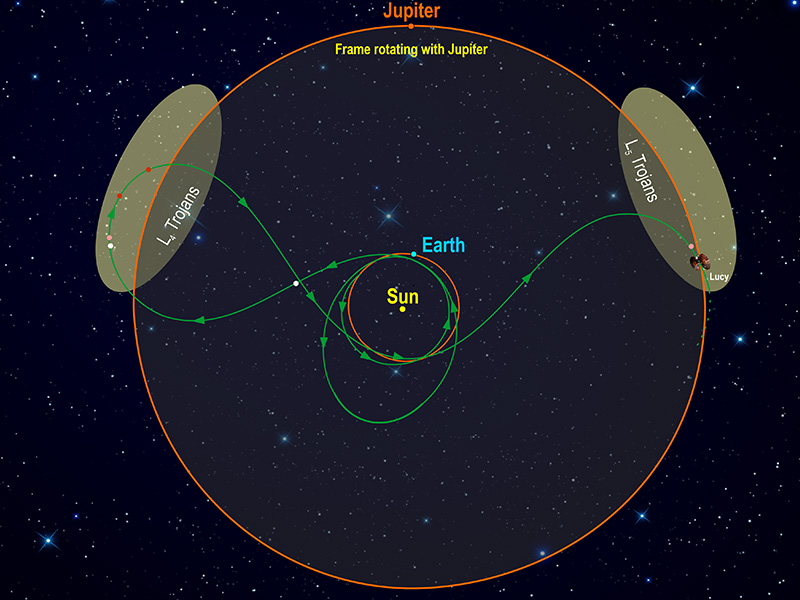
Southwest Research Institute
We’ve never explored these worlds up close before, and the spacecraft will visit seven of them, one after the other. But it’s only got one shot: Lucy will shoot past each object with no second chances. Ground-based observations, taken as we wait for Lucy to traverse the solar system, are our best chance to prepare for these flybys, and they’re already turning up some unexpected findings.
Marc Buie (Southwest Research Institute) has led an innovative campaign to view such worlds, which are too small and too far away to make out with telescopes. He and the teams of observers who have joined his group observe occultations, in which a body passes in front of a distant star and causes it to momentarily wink out of sight. By timing the winking-out from multiple locations, astronomers can trace out chords that help map the body’s shape.
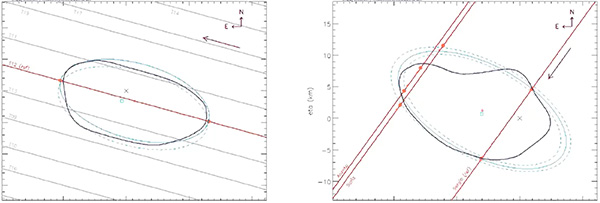
Marc Buie
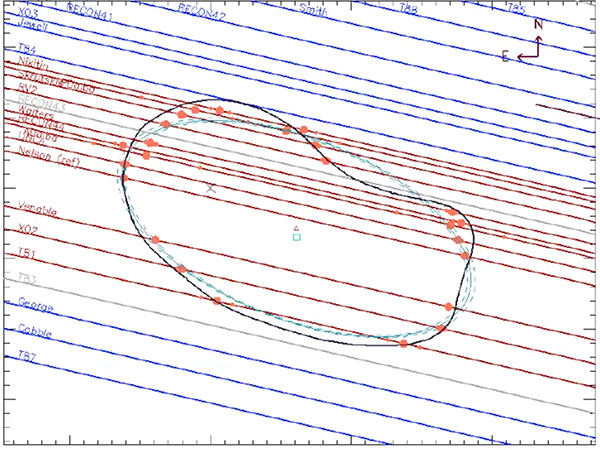
Marc Buie
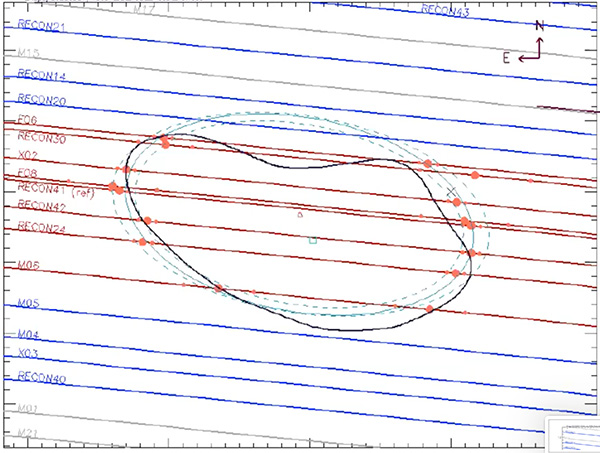
Marc Buie (SWRI)
Presenting earlier this month at the Division of Planetary Sciences (DPS) in London, Canada, Buie showed results from multiple campaigns observing one of Lucy’s targets, Polymele. He noted that his colleague, Stefano Mottola (DLR), had translated the chords collected over these campaigns into a shape model, which suggests the asteroid has a distinctly irregular shape: a bumpy and flattened spheroid that brings to mind a poorly shaped burger patty.
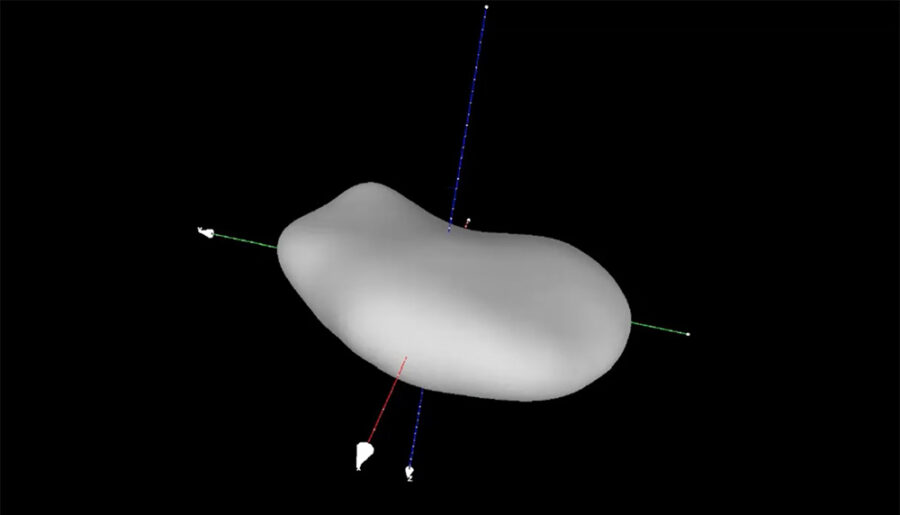
Stefano Mottola (DLR)
And that’s not all. Two observers of the March 2022 observing campaign got lucky and saw their star wink out a second time. The two chords obtained from their observations point to a moon for Polymele, roughly 5 kilometers (3 miles) in diameter. The moon, dubbed Shaun, orbits Polymele every 22 days or so from a distance of about 130 km.
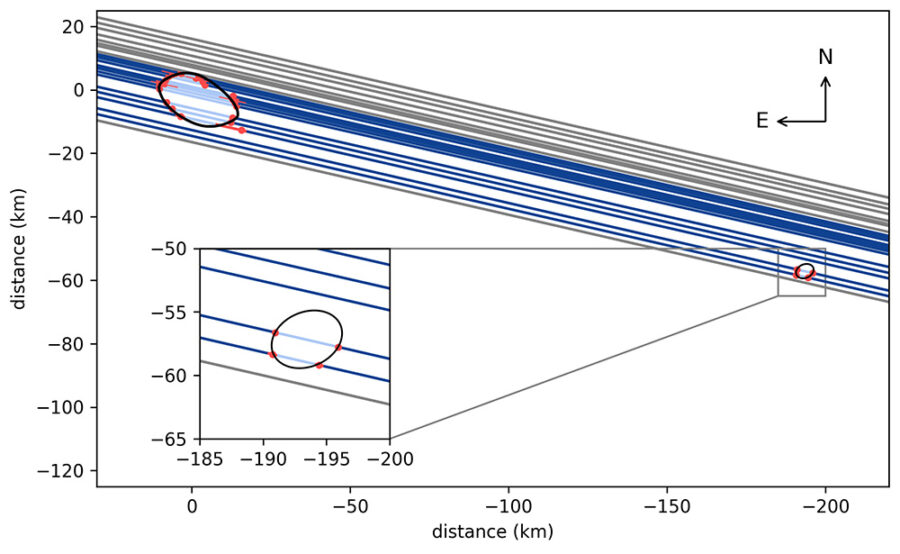
NASA Goddard Space Flight Center
Buie remarked that Polymele’s shape and size, as well as that of its moon, are similar to double-lobed Arrokoth, New Horizon’s post-Pluto target in the icy outskirts of the solar system. (Arrokoth, like Polymele, was first observed via occultation campaigns that Buie led before New Horizons passed it by.)
NASA / Johns Hopkins University APL / SWRI / James Tuttle Keane
Astronomers are beginning to realize that double-lobed asteroids make up a significant number of smaller solar system bodies, possibly due to their formation. In the going theory, called streaming instability, a dusty disk around a newborn star first collapses into filaments and then into clumps, which then merge into larger worlds. “I wonder if Polymele isn’t the same as Arrokoth,” Buie speculates, “it just didn’t merge.”
Occultation campaigns can target objects far beyond those the New Horizons and Lucy missions aim for. The European Space Agency’s Gaia satellite provides the exact positions of distant stars in the Milky Way, which makes it easier to predict when and where observers will see the occultation briefly block a background star.
At the DPS meeting, Buie said he now has the capability — if not yet all the funding — to use occultations to measure the shape of any body over 1 kilometer across. All he needs are the telescopes at the right time and place to see them. Campaigns to follow up on targets of the Lucy mission are ongoing via a program called Research and Education Collaborative Occultation Network (RECON). However, the potential exists to go far beyond these targets.
Running occultation observing campaigns is technically and logistically complicated, but Buie says the pay-offs are huge: “I’m after nothing less than the origins of the solar system.”
 9
9









Comments
Anthony Barreiro
October 13, 2022 at 5:56 pm
Does Dr. Buie collaborate with amateur astronomers through the International Occultation Timing Association? You don't need a big telescope to observe an asteroid occulting a star. Several modestly sized telescopes recording high speed video are arrayed across the predicted path of the occultation. Amateurs are able to make significant contributions, and their volunteer efforts defray the expense of these campaigns.
You must be logged in to post a comment.
Chris-Patrick
October 14, 2022 at 4:27 pm
Yes. Dr. Buie collaborates with amateur astronomers through both IOTA and an organization called RECON (Research and Education Collaborative Occultation Network. I am a member of both IOTA and RECON. RECON consists of a network of about 60 telescopes dispersed from Yuma, Az. into British Columbia. These telescopes are manned by volunteers from schools and private individuals. Most of the telescopes are in the 11 to 12" aperture range. Most, if not all of the RECON scopes use QHY174M cameras with GPS. Here is a link to RECON for more information: http://tnorecon.net/about-us/
You must be logged in to post a comment.
Monica YoungPost Author
October 14, 2022 at 4:37 pm
Thanks, Chris! For some reason, that website wasn't working for me a few days ago, but it is now so I've added it to the story.
You must be logged in to post a comment.
Anthony Barreiro
October 14, 2022 at 5:43 pm
Thank you.
You must be logged in to post a comment.
Chris-Patrick
October 15, 2022 at 11:31 am
You're welcome!
You must be logged in to post a comment.
Ted Swift
October 17, 2022 at 1:58 am
It would be worth adding IOTA's main web site, https://occultations.org/, which provides lots of information.
And by "modest sized", many amateur observers use 200 mm or smaller telescopes, and brighter events can be recorded with as little as 70 mm apertures. Amateurs record hundreds of observations all over the world each year. The rate is approaching 1000/year. Contributions include determining asteroid size and shape (which in turn improves albedo estimates) and astrometry (which improves future orbital predictions).
You must be logged in to post a comment.
Martian-Bachelor
October 17, 2022 at 7:17 pm
I'd also say one of the things that has changed is the advent of widely available solid state detectors in modern cameras. Forty years ago, to do good photometry with sufficient time resolution, one needed a dry-ice cooled, kilo-volt powered, photo-multiplier tube, and some fairly sophisticated back-end electronics. Not many amateurs or even small college observatories had that kind of capability.
A couple of years ago I was able to get Pluto with a single 30 second exposure using a 70mm aperture lens on a (decade old) DSLR. Compared to when Clyde Tombaugh first recorded it, I calculated my unextraordinary setup was something like nearly 2,000 times more senstive.
You must be logged in to post a comment.
Frank-ReedNavigation.com
October 16, 2022 at 12:47 pm
What has actually changed? What has made this hoary old method now "innovative"? The technique described here --multiple observers arrayed along an occultation path, collecting photometric data, and then generating body chords which can be used to model the asteroid shape-- has of course been around for decades. I can recall learning about it as a teenager in the pages of S&T itself. It's not the method that's new. It's all the subsidiary tools that make the results of this mapping technique much superior today to what they were forty years ago. Paul Maley's occultation page, https://eclipsetours.com/paul-maley/occultations/, shows some excellent examples including the amazing profile of the large asteroid Pallas generated from hundreds of occultation chords as it passed in front of 1 Vul in 1982. So what's changed? Two obvious answers: computing power and satellite navigation. Computing power allows generation of accurate ephemerides and exact topocentric occultation paths, even for very small asteroids and objects with significantly perturbed orbits. Secondarily, computing power provides vast search capabilities that permit the identification of obscure occultations that would never have been noticed even 20 years ago. Equally important, GNSS satellites (such as GPS) allows observers to position themselves exactly where required for maximum coverage of chords across an asteroid, and also, less remembered, those same GNSS satellites provide highly accurate timing of these events almost perfectly synchronized for all observers. Enabling technology. That's what has changed...
You must be logged in to post a comment.
Monica YoungPost Author
October 17, 2022 at 9:17 am
Hi Frank, In his talk, Marc Buie also emphasized the importance of Gaia data in making this technique applicable to km-scale bodies across the solar system.
You must be logged in to post a comment.
You must be logged in to post a comment.